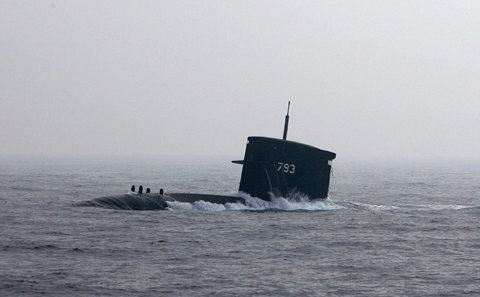|
¡@
Study warns of submarine arms race
TREND: The Heritage Foundation report said China has
dramatically expanded its Navy since the end of the Cold War, adding dozens of
attack subs since 1995
By William Lowther
STAFF REPORTER IN WASHINGTON
Friday, Feb 05, 2010, Page 1
¡@

An SS-793 Hai Lung-class submarine emerges
from the sea near Kaohsiung on Jan. 26.
PHOTO: REUTERS
With the US stalling on Taiwan¡¦s request to purchase diesel-electric submarines,
The Heritage Foundation said in a study that there is now a ¡§submarine arms
race¡¨ in the Pacific Ocean.
The 13-page study says that since the end of the Cold War, China has
dramatically expanded its Navy, especially its submarine fleet, adding dozens of
attack subs since 1995.
During the same period, Heritage said, the US attack sub fleet shrank to 53 and
is projected to fall to 41 by 2028.
¡§The US fleet is already stretched thin by the demands of ongoing operations,¡¨
the report says. ¡§Australia, India and other Pacific countries have taken note
of the shifting balance and have responded with their own naval buildups,
particularly of their submarine fleets. Unless the US stops ¡X and reverses ¡X the
decline of its own fleet, US military superiority in the Pacific will continue
to wane, severely limiting the Navy¡¦s ability to operate in the region, to
protect US interests, and to support US friends and allies.¡¨
Concerning Taiwan, the study says it ¡§operates two attack submarines and has
explored numerous options to expand and upgrade its submarine fleet, including
domestic construction.¡¨
¡§In 2001, the US offered Taiwan an arms package that included eight
diesel-electric submarines, but the US does not own the rights to any current
diesel submarine designs and the proposal appears to be dead,¡¨ it says.
Some Washington analysts dispute this, however, and suggest that Australia could
provide Taiwan with submarine designs.
Australia has six diesel-electric submarines and has announced plans to replace
them with 12 modern conventional submarines armed with cruise missiles.
¡§The Australian government has explicitly tied this expansion to the rise of
China as a naval power and weakening US naval supremacy, which Australia
believes has played a stabilizing role, especially in the Asia-Pacific region,¡¨
the study says.
The study recommends that the Pentagon re-evaluate the use of diesel submarines.
¡§Congress should direct the Navy to study the utility of using attack
submarines,¡¨ it says.
¡§Developing a US conventional submarine capability would facilitate more robust
training and afford the US the option to sell advanced diesel submarines to
Taiwan,¡¨ it says.
The study was written for Heritage by Mackenzie Eaglen and Jon Rodeback, both
analysts at the think tank.
¡§The continuing decline of the US submarine fleet threatens US undersea
supremacy in the Pacific and therefore could seriously undermine the Navy¡¦s
ability to operate effectively in East Asia and the Pacific,¡¨ the report
concludes.
Meanwhile, Forbes magazine is predicting that China¡¦s threat to impose sanctions
on companies making weapons for Taiwan could be ¡§particularly damaging.¡¨
Four major companies are involved ¡X Raytheon, Boeing, United Technologies and
Lockheed Martin.
Boeing and United Technologies are actively operating in China.
¡§The aircraft industry has been looking to the growing Asian market to
rehabilitate sales and revive the industry,¡¨ Forbes said.
Global air travel dropped by 2 percent last year, but domestic air travel in
China jumped 21 percent.
Boeing estimates that China will need 3,800 new airplanes in the next 20 years
at a cost of US$400 billion.
¡§If China imposes the threatened sanctions, Boeing could lose out on the Chinese
market and fall further behind its rival Airbus,¡¨ Forbes said.
¡§The US company is already hurting after several rounds of developmental delays
led its 787 Dreamliner aircraft to take its first flight two years behind
schedule,¡¨ it said.
Raytheon ¡X builder of the Patriot Missile System ¡X has a number of valuable
contracts in China, including plans to provide an air-traffic-control system for
Shenyang Airport.
¡@
|
![]()
![]()
![]()